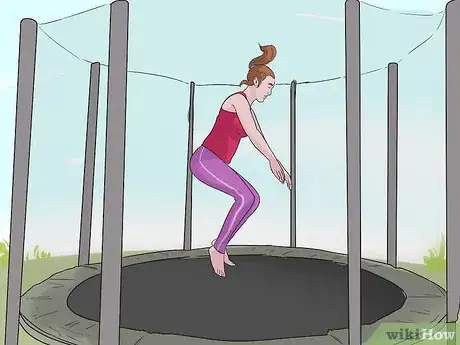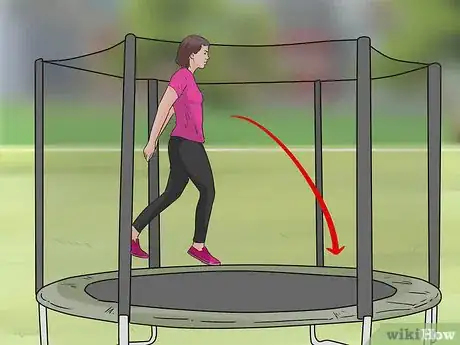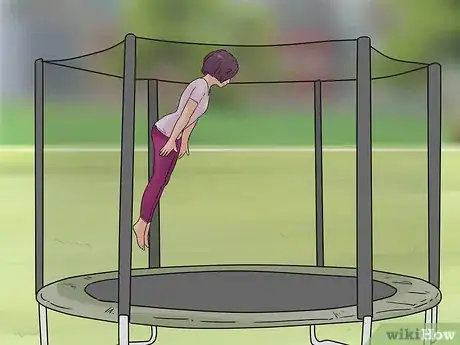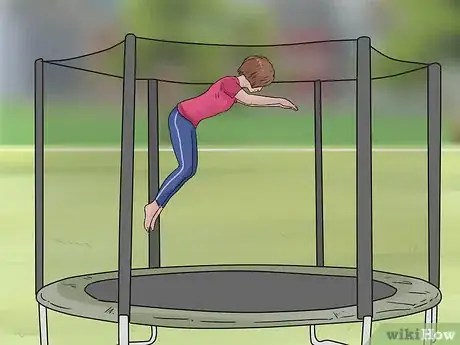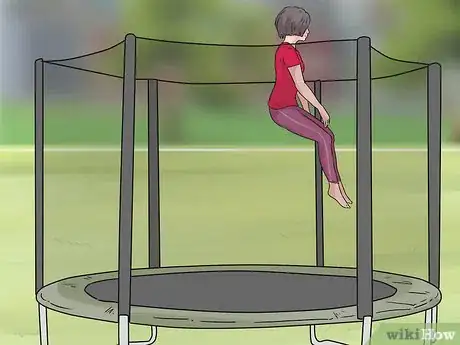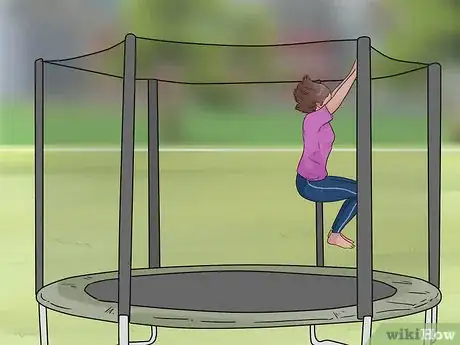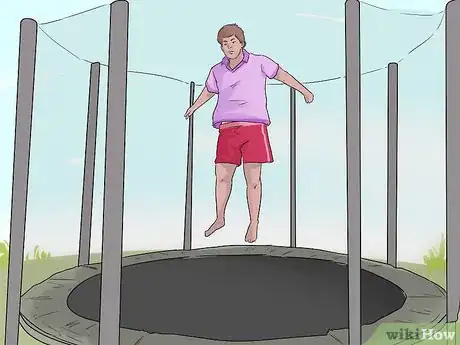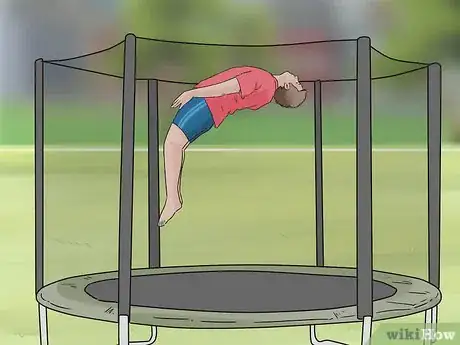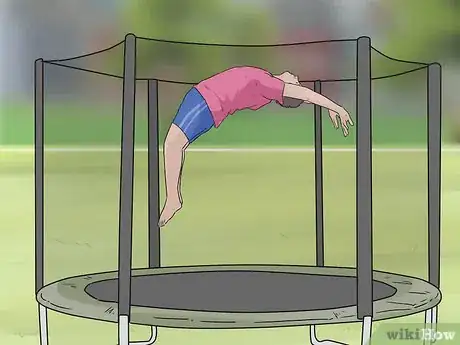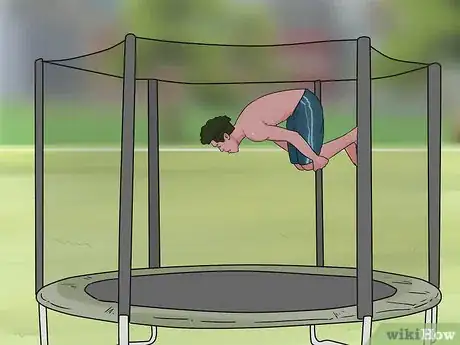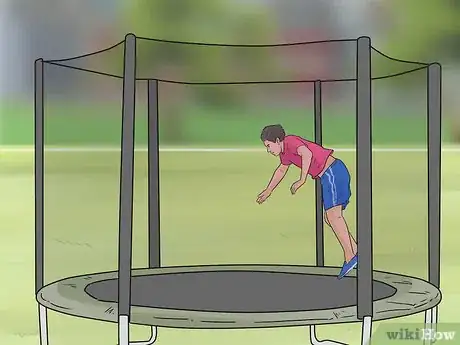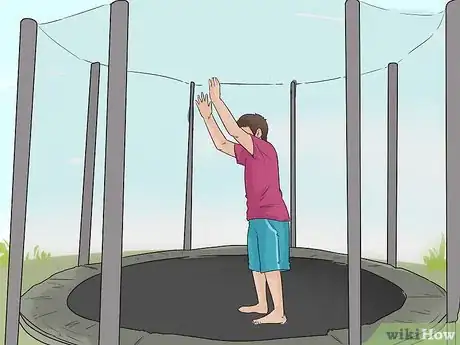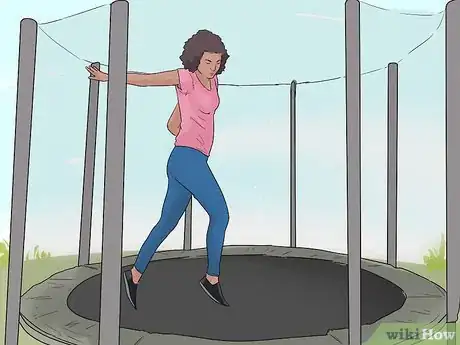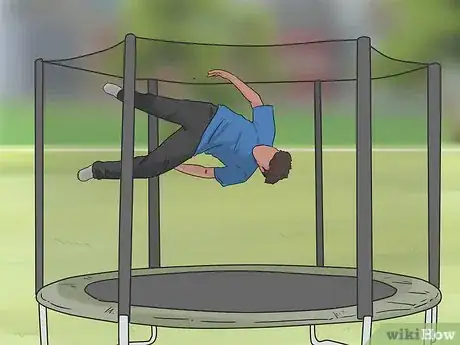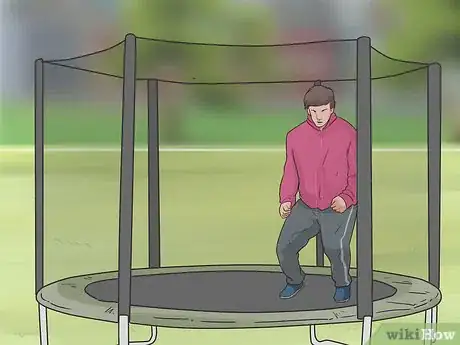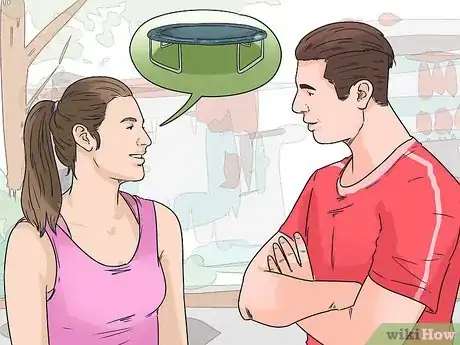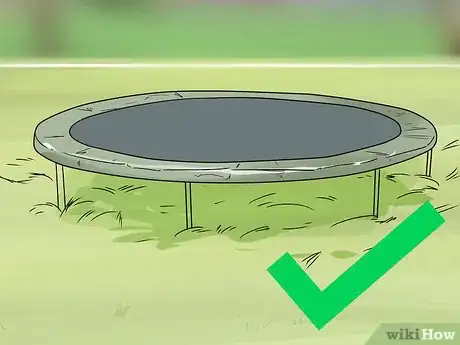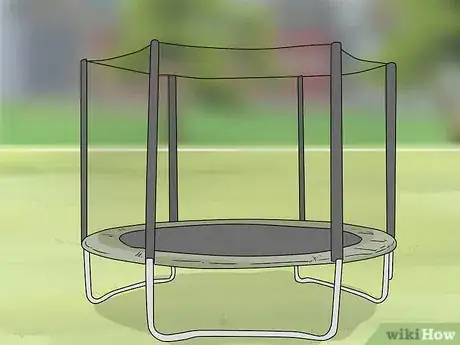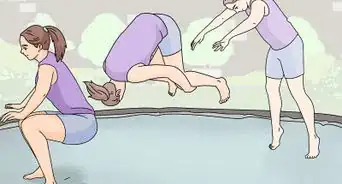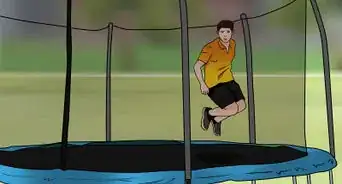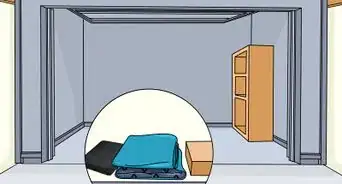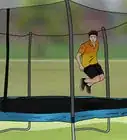This article was co-authored by Tanya Berenson. Tanya Berenson is a Gymnastics Instructor and the General Manager of the Los Angeles School of Gymnastics. With over 25 years of professional gymnastics experience, Tanya has also served as a consultant to USA Gymnastics, has served as the USA World Maccabi Games Head Coach, USA Gymnastics Meet Director, and RAS counselor. She holds a B.Ed. in Early Childhood Development from the University of California, Los Angeles.
There are 7 references cited in this article, which can be found at the bottom of the page.
This article has been viewed 121,699 times.
Using a trampoline makes for good exercise at home. Once you bounce for a while, however, you'll want to do more. Flips are a flashy choice for mastering balance and impressing your friends. Without proper technique, however, they are dangerous. Learn how to flip like a professional gymnast by straightening your body, tucking in, and sticking the landing.
Steps
Doing a Frontflip
-
1Bounce high. After you feel warmed up, bounce in a single spot. Keep your back straight. Bounce a few times to build momentum, then bounce as high as possible before beginning your flip.
-
2Watch a spot ahead of you. Pick a notable spot ahead of you, such as a spot on the wall or a ball someone left out. Your head should be held straight. Watch this object as long as you can while beginning the flip. It will help you monitor what position your body is in during the flip.
- Remember this spot so that you can find it again and use it to initiate your landing.
Advertisement -
3Lean forward slightly. Incline yourself slightly forward during your last bounce. Your head and back will be angled slightly ahead of a neutral standing position. Like during a backflip, this ensures that you get enough of a trajectory to complete your flip.
-
4Extend your arms. At the peak of your bounce, shoot your arms up to generate force. Keep them bent a little like you're throwing a ball over your head. Quickly straighten your arms when the flip begins. Hold your body straight as you begin to tumble forward.
-
5Tuck your knees. Bring your knees up towards your chest. Move your arms downward, trying to reach for your calves instead of your knees. The tighter you can make yourself, the faster you'll rotate.
-
6Straighten yourself. When you see the spot you had chosen before, begin to uncurl your body. Bring your arms straight out to help you balance. Return your head to its usual position, straight and looking forward.
-
7Stick the landing. Bend your legs before you land to avoid causing damage to your knees. Aim to land on the balls of your feet first. When your feet first hit the ground, bring down your heels to stabilize yourself.
Performing a Backflip
-
1Bounce high. Backflips seem scarier but are easier to perform than front flips. After warming up and getting a feel for the trampoline by bouncing, begin to bounce in one spot. Stand straight with your hands against your side. On your highest bounce, prepare to flip.
- It may be helpful to choose a number between four and eight. Count your bounces. On the number you chose, make that bounce your highest and start the flip.
- Jump at least 6 ft (1.8 m) in the air before you prepare to flip.[1]
-
2Lean back slightly. In order to complete the flip, you'll need to create the proper trajectory. Lean slightly back when you rise on your last trampoline bounce. Your back, shoulders, neck, and head should point slightly behind the straight position you had when bouncing.
- If you lean back too far, you won't have enough momentum. If you lean forward, you will have a harder time flipping.
-
3Raise your arms. Right when you reach the pinnacle of your bounce, shoot your arms up hard over your head, slightly bent like you're going to throw a ball backwards. Straighten them quickly before you start tumbling. It's important to do this with force to help start your rotation.
-
4Tuck in your body. As you begin to fall backwards, bring your legs into your chest. At the same time, bring your arms down. Reach for your knees and pull hard. Also tighten your abs to help pull you through your rotation.
-
5Open yourself up. Once your sight goes past the trampoline to the area beyond, it's time to prepare for landing. Position yourself by uncurling your legs. Bring your arms out to help you maintain your balance.
-
6Stick the landing. Before your feet hit the ground, bend your legs slightly. Never lock your legs while bending or else the impact will damage your knees. Try to land on the balls of your feet first before your heels hit the ground.
- In case you begin to fall, don't brace yourself with your hands. This may cause wrist damage.
Flipping Sideways
-
1Start bouncing. Side flips work the same way as other flips, except the motion feels more awkward. Start out as normal, standing straight while bouncing in place on the trampoline. During your highest bounce, prepare to start your flip.
-
2Pull your head and shoulders to the side. At the top of your bounce, pull your head and shoulders to the side as hard as you can. This creates momentum towards whatever way you chose.
- Your arms aren't used for momentum in this flip, so it isn't necessary to raise them.
-
3Push your hips out. In the opposite direction of your head and shoulders, push your hips. You may be tempted to push your body backwards, but keep it straight as you move your hips to the side. This movement gives you a little extra rotation in your lower body to help you complete the flip.
-
4Tuck your legs. Like you do in any flip, bring your legs up into your chest. Bring your arms down to your knees or calves to help you rotate. Tighten yourself into a ball as much as possible to complete the flip.[2]
-
5Straighten yourself. At the end of the flip, bring your legs back out. Keep your legs slightly bent as your feet hit the trampoline. Bring your arms straight out if you need them to balance.
-
6Land safely. Bend your legs a little before hitting the ground. Try to land on the balls of your feet first. Keep your feet shoulder-width apart if possible. This gives you the most stability when landing.
Flipping Safely
-
1Get supervised training first. Using a trampoline can be very dangerous, so it is best to train first in a safe environment. Training happens in lessons for competitive sports including gymnastics and diving. There, a teacher or coach can help you learn how to use a trampoline properly.[3]
- Improper use of a trampoline can lead to severe head and spinal injuries. Flipping increases your chances of this.
- Flips should not be attempted until you feel completely comfortable using a trampoline.
-
2Choose a cushioned area. The ideal area to place your trampoline is a level surface away from any obstacles, including trees, fences, and lawn equipment. Place the trampoline on absorbent ground such as a grassy lawn, wood chips, or sand. Add padded mats for extra protection.[4]
- Proper cushioning shields you when you fall. The motion and momentum from flipping makes bone fractures more likely.
-
3Install safety pads. Safety padding is brightly-colored shielding that goes around the edges of the trampoline, covering the frame and springs. Order padding online or choose a trampoline that has the thickest padding possible. The frame is a hard surface and can also cause fractures if you land on it.[5]
-
4Enclose the trampoline in a safety net. Never get on the trampoline until you have ordered a net and placed it securely around the trampoline. When you fall, the net will slow your momentum or catch you before you hit the ground. This is important in flipping because of all the movement you'll be doing.[6]
-
5Limit it to one person on at a time. Bigger trampolines have enough space for more than one person, but this isn't safe. Besides the difficulty in controlling your motion when multiple people jump, the other person can easily bump into you and send you flying. The lighter person on the trampoline is more likely to get hurt.
-
6Don't jump off. Jumping off while flipping creates a heavy impact that can damage your knees and break your ankles, but this applies to regular jumping too. Instead, stay in place until you come to a halt. Walk to the edge of the trampoline and step or slide off.[7]
Expert Q&A
-
QuestionHow do you maintain your balance?
 Tanya BerensonTanya Berenson is a Gymnastics Instructor and the General Manager of the Los Angeles School of Gymnastics. With over 25 years of professional gymnastics experience, Tanya has also served as a consultant to USA Gymnastics, has served as the USA World Maccabi Games Head Coach, USA Gymnastics Meet Director, and RAS counselor. She holds a B.Ed. in Early Childhood Development from the University of California, Los Angeles.
Tanya BerensonTanya Berenson is a Gymnastics Instructor and the General Manager of the Los Angeles School of Gymnastics. With over 25 years of professional gymnastics experience, Tanya has also served as a consultant to USA Gymnastics, has served as the USA World Maccabi Games Head Coach, USA Gymnastics Meet Director, and RAS counselor. She holds a B.Ed. in Early Childhood Development from the University of California, Los Angeles.
Gymnastics Instructor Start jumping up and down on the trampoline for several minutes. As you do this, you can create big arm circles to gain your balance. Also, look for a point that's directly in front of you, which will help you maintain your balance.
Start jumping up and down on the trampoline for several minutes. As you do this, you can create big arm circles to gain your balance. Also, look for a point that's directly in front of you, which will help you maintain your balance. -
QuestionHow can I train for a front flip?
 Tanya BerensonTanya Berenson is a Gymnastics Instructor and the General Manager of the Los Angeles School of Gymnastics. With over 25 years of professional gymnastics experience, Tanya has also served as a consultant to USA Gymnastics, has served as the USA World Maccabi Games Head Coach, USA Gymnastics Meet Director, and RAS counselor. She holds a B.Ed. in Early Childhood Development from the University of California, Los Angeles.
Tanya BerensonTanya Berenson is a Gymnastics Instructor and the General Manager of the Los Angeles School of Gymnastics. With over 25 years of professional gymnastics experience, Tanya has also served as a consultant to USA Gymnastics, has served as the USA World Maccabi Games Head Coach, USA Gymnastics Meet Director, and RAS counselor. She holds a B.Ed. in Early Childhood Development from the University of California, Los Angeles.
Gymnastics Instructor Many people assume that flipping is just throwing your bodyweight forward or backward and hoping that you land. A lot of your flipping strength actually comes from your core, so focus on core training, along with asymmetrical training and repetition.
Many people assume that flipping is just throwing your bodyweight forward or backward and hoping that you land. A lot of your flipping strength actually comes from your core, so focus on core training, along with asymmetrical training and repetition. -
QuestionI can do the frontflip but I land on my butt. When do I untuck?
 Community AnswerUntuck near the end of the flip. Before you flip, choose a point of reference. It can be anything you see without moving or bending your head, such as a person or a feature on the wall. When you see that spot again, you'll know it's time to untuck.
Community AnswerUntuck near the end of the flip. Before you flip, choose a point of reference. It can be anything you see without moving or bending your head, such as a person or a feature on the wall. When you see that spot again, you'll know it's time to untuck.
Warnings
- Attempting flips can result in serious injuries. Learn the proper technique before trying.⧼thumbs_response⧽
- If you fall, try not to brace yourself with your hands. This will help you avoid wrist damage.⧼thumbs_response⧽
- Keep your legs bent a little when you land so that the impact doesn't hurt your knees.⧼thumbs_response⧽
- Don't attempt a flip if you aren't confident in your ability.⧼thumbs_response⧽
References
- ↑ Tanya Berenson. Gymnastics Instructor. Expert Interview. 22 May 2020.
- ↑ https://www.trampolinegurus.com/cool-trampoline-tricks/
- ↑ https://www.healthychildren.org/English/safety-prevention/at-play/Pages/Trampolines-What-You-Need-to-Know.aspx
- ↑ http://www.rospa.com/leisure-safety/advice/trampoline/
- ↑ http://www.mayoclinic.org/healthy-lifestyle/childrens-health/expert-answers/trampoline-exercise/faq-20058001
- ↑ https://health.clevelandclinic.org/2015/04/surprising-dangers-of-trampolines-for-kids/
- ↑ https://www.nationwide.com/trampoline-safety.jsp
About This Article
With the right technique, flips are an impressive and fun trick you can do on the trampoline. To do a frontflip, you’ll need to bounce pretty high so you’ll have time to flip over in the air. Once you’re high in the air, tuck your knees into your chest and lean forward to spin. When you’re the right way up again, straighten your legs and arms to land. When you’re starting out, try landing on your knees until you get comfortable with flipping in the air, then try to land on your feet. Always bend your legs when you land on the trampoline to help you absorb the impact. For more tips, including how to do a backflip on the trampoline, read on!
